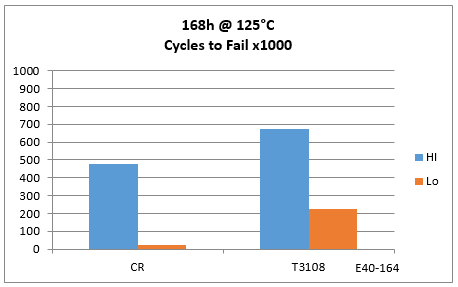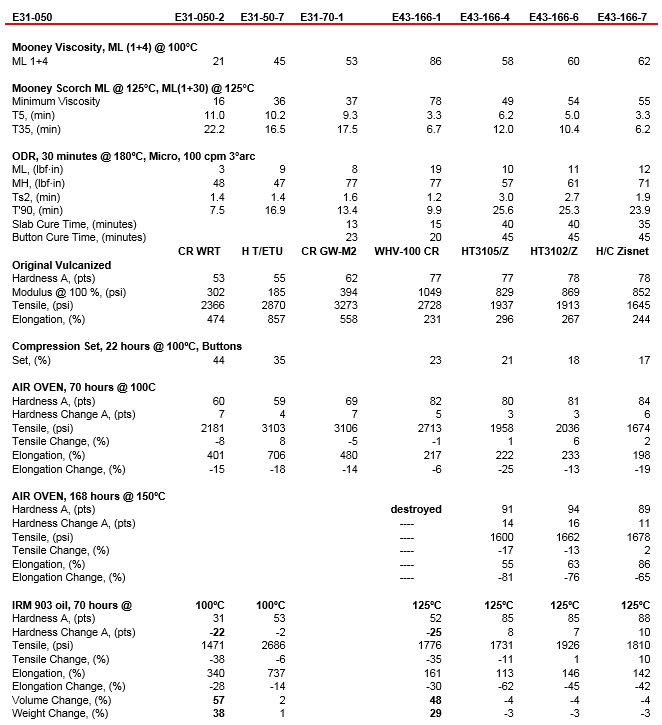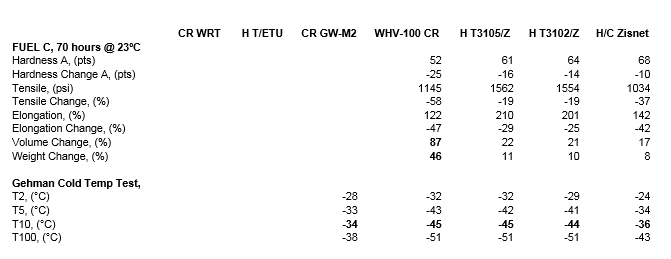Hydrin Elastomers as a Candidate for Replacing or Supplementing Polychloroprene Rubber
Hydrin®/GECO (terpolymer) type elastomers can be polymerized in such a way as to enhance performance in dynamic (flex fatigue) applications. Technology advances have enabled the commercialization of another GECO terpolymer, Hydrin T3108, which can be used to replace or supplement polychloroprene.
INTRODUCTION TO ECO
Polyepichlorohydrin offers an excellent balance of properties, combining key properties that are useful in engine compartments: high temperature, oil, fuel, and ozone resistance. Applications include fuel hoses, emission tubing, air ducts, and diaphragms. The homopolymer has excellent permeation resistance, making it a candidate for A/C hose and oil field down-hole applications. In addition, Hydrin copolymers and terpolymers are electro-statically dissipative. This property makes them useful in certain roll applications, such as printer rollers. The SAE J200/ASTM D2000 designation is CH for the copolymer of epichlorohydrin and ethylene oxide, indicating a service temperature of 125C. A properly formulated Hydrin compound can have heat resistance to 168 hours @ 150C.
HISTORY
High molecular weight polyethers were predicted to exhibit interesting physical properties, due to the presence of the oxygen atoms in the polymer backbone, which imparts more flexibility to the polymer chain. Also, a saturated polymer chain provides excellent ozone resistance.
The American Society for Testing and Materials (ASTM) has designated Hydrin polymers as shown in Table 1.
FORMULATING
The formulating of ECH\ECO\GECO compounds is very much the same as developing a compound for more common elastomers, i.e., SBR, EPDM, NBR, etc. Typical carbon blacks, white fillers, and process aids can be used, along with various antioxidants (metal dithio-carbamates, amines, and imidazoles).
Plasticizers that are close to the same polarity as the polymer should be used, to a maximum of approximately 30 phr, depending on the filler level. These plasticizers are usually diesters and ethers. Examples of compatible plasticizers are DOP (Dioctyl phthalate), DIDP (Diisodecyl phthalate), and DBEEA (Di (butoxy-ethoxy-ethyl) adipate).
CURATIVES
The homopolymer (ECH) and the copolymer of ECH and EO, are fully saturated, so traditional cure systems are not used with these polymers. However, the AGE containing polymers, GCO and GECO types, can be readily cured by sulfur and peroxide. This is because the AGE introduces unsaturation in a side chain.
For CO\ECO elastomers, unique cure packages are often required. Ethylene thiourea (ETU) and lead oxide was the cure system of choice. Changing environmental regulations led to the use of non-lead cure systems. Ethylene Thiourea is a suspected carcinogen in humans, while exposure to ethylene thiourea poses a risk of teratogenesis. (https://www.cdc.gov/niosh/docs/78-144/default.html).
NON-LEAD / ALTERNATIVE CURE SYSTEMS
A viable lead and ETU free cure system for Hydrin elastomers is Zisnet F-ET a triazine. The cure rate is readily adjustable. Table 3 shows how to adjust the cure rate of a triazine (Zisnet F-ET) cure package by varying accelerators and retarders.
PROCESSING SECTION – Mixing/Milling
Polyepichlorohydrin compounds can be mixed on a mill or in an internal mixer. The mixing procedure for either method is virtually the same as for SBR, NBR, and EPDM compounds. Because of shelf life concerns, a two-pass mix may be preferable.
Mill roll surface preparation is extremely important. These compounds tend to stick to mill roll surfaces when certain residues, from other compounds with different polymer types, remain on the rolls. This condition usually occurs erratically. Not all residues cause sticking. One of the residues they seem to adhere to the most (re: worst), is from a peroxide cured EPDM compound. The mill rolls must be thoroughly cleaned to consistently avoid problems with sticking. Millathane Glob has been an effective, safe method of cleaning the rolls.
Specific to polyepichlorohydrin compounds, the mill rolls should be residue free and up to 60 - 80 C. Both items are to alleviate the compound sticking to the mill roll surfaces.
COMPARISON WITH CR
In the study shown below, a flex-fatigue resistant polychloroprene stock is compared with one utilizing the T3108 polymer. As can be seen in the DeMattia data, T3108 can have superior flex-fatigue, especially on exposure to higher thermal environments. The data shown illustrates the improved flex-fatigue results at room temperature (as-molded), at 115°C and at 125°C. A series of 3-bars were molded for each condition. The high and low result in cycles to failure (0.5"crack or break) or 1 MM cycles are both shown. The T3108 specimen out-performed the Neoprene stock, as shown in Figures 1- 3.
Figure 1
Figure 2
Figure 3
In this same study, compounds were compared using the typical hardness & stress/strain properties. Under the most severe heat aging condition used in this study, 168 hours @ 125 C, the Hydrin terpolymer compound cured with triazine (Zisnet F-ET) gave the best results, as shown in Figure 4.
Figure 4
Hydrin and Blends with NBR
Lab work was performed to develop a Hydrin compound for underground conveyor belts. The blends were 60/40 Hydrin/NBR. The types of nitrile elastomers used were High ACN (Nipol DN4555), high butadiene content (Nipol N117), and carboxylated NBR (Nipol NX774).
Hydrin had superior electrical (static-dissipation) and flame resistance results, which are important properties for underground conveyor belts.
Polymer and Cure System Comparisons
In other studies, various CR and Hydrin elastomers were used in compounds with different formulas and the test results are shown for more comparisons. Hydrin compounds showed more resistance to Fuel C & IRM 903 oil, and then in air at the higher temperatures.
Hydrin & CR Comparisons including ETU Cure System
Summary/Conclusion(s)
Hydrin compounds show superior resistance at higher temperatures than CR ones, including 168 hours @ 150 C, and have substantially less volume swell in IRM903 oil and fuel.
A study has shown Hydrin compounds to match or exceed CR ones in flex life (DeMattia).
Zisnet F-ET is an effective, safer cure system than ETU, with a readily adjustable cure rate.
Hydrin and CR elastomers have very similar low temperature flex.
Hydrin elastomers can used to replace or supplement CR in both non-automotive and automotive applications, such as conveyor belts, air ducts, and cold side turbocharger hoses
Author: Clark Cable - Applications Development Scientist, Zeon Chemicals L.P.










